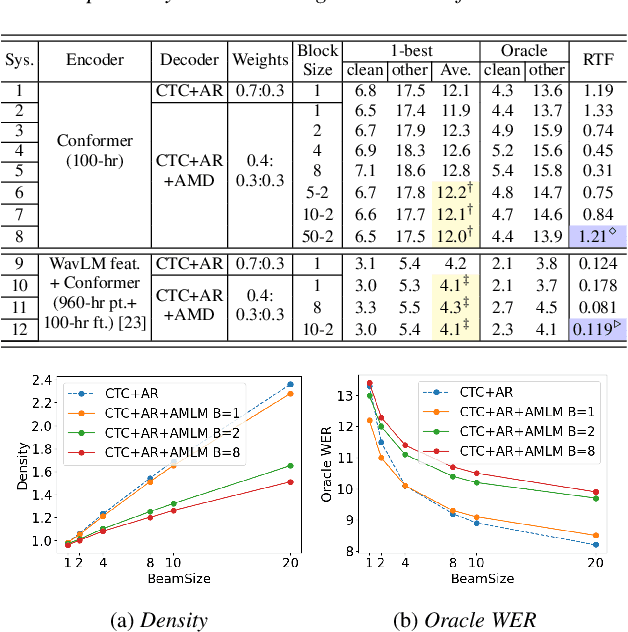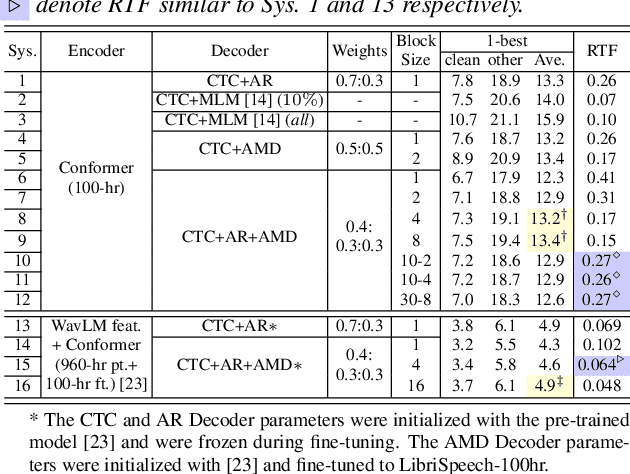Mingyu Cui
Structured Speaker-Deficiency Adaptation of Foundation Models for Dysarthric and Elderly Speech Recognition
Dec 25, 2024Abstract:Data-intensive fine-tuning of speech foundation models (SFMs) to scarce and diverse dysarthric and elderly speech leads to data bias and poor generalization to unseen speakers. This paper proposes novel structured speaker-deficiency adaptation approaches for SSL pre-trained SFMs on such data. Speaker and speech deficiency invariant SFMs were constructed in their supervised adaptive fine-tuning stage to reduce undue bias to training data speakers, and serves as a more neutral and robust starting point for test time unsupervised adaptation. Speech variability attributed to speaker identity and speech impairment severity, or aging induced neurocognitive decline, are modelled using separate adapters that can be combined together to model any seen or unseen speaker. Experiments on the UASpeech dysarthric and DementiaBank Pitt elderly speech corpora suggest structured speaker-deficiency adaptation of HuBERT and Wav2vec2-conformer models consistently outperforms baseline SFMs using either: a) no adapters; b) global adapters shared among all speakers; or c) single attribute adapters modelling speaker or deficiency labels alone by statistically significant WER reductions up to 3.01% and 1.50% absolute (10.86% and 6.94% relative) on the two tasks respectively. The lowest published WER of 19.45% (49.34% on very low intelligibility, 33.17% on unseen words) is obtained on the UASpeech test set of 16 dysarthric speakers.
A Comparative Study of Discrete Speech Tokens for Semantic-Related Tasks with Large Language Models
Nov 13, 2024Abstract:With the rise of Speech Large Language Models (Speech LLMs), there has been growing interest in discrete speech tokens for their ability to integrate with text-based tokens seamlessly. Compared to most studies that focus on continuous speech features, although discrete-token based LLMs have shown promising results on certain tasks, the performance gap between these two paradigms is rarely explored. In this paper, we present a fair and thorough comparison between discrete and continuous features across a variety of semantic-related tasks using a light-weight LLM (Qwen1.5-0.5B). Our findings reveal that continuous features generally outperform discrete tokens, particularly in tasks requiring fine-grained semantic understanding. Moreover, this study goes beyond surface-level comparison by identifying key factors behind the under-performance of discrete tokens, such as limited token granularity and inefficient information retention. To enhance the performance of discrete tokens, we explore potential aspects based on our analysis. We hope our results can offer new insights into the opportunities for advancing discrete speech tokens in Speech LLMs.
Improving Grapheme-to-Phoneme Conversion through In-Context Knowledge Retrieval with Large Language Models
Nov 12, 2024Abstract:Grapheme-to-phoneme (G2P) conversion is a crucial step in Text-to-Speech (TTS) systems, responsible for mapping grapheme to corresponding phonetic representations. However, it faces ambiguities problems where the same grapheme can represent multiple phonemes depending on contexts, posing a challenge for G2P conversion. Inspired by the remarkable success of Large Language Models (LLMs) in handling context-aware scenarios, contextual G2P conversion systems with LLMs' in-context knowledge retrieval (ICKR) capabilities are proposed to promote disambiguation capability. The efficacy of incorporating ICKR into G2P conversion systems is demonstrated thoroughly on the Librig2p dataset. In particular, the best contextual G2P conversion system using ICKR outperforms the baseline with weighted average phoneme error rate (PER) reductions of 2.0% absolute (28.9% relative). Using GPT-4 in the ICKR system can increase of 3.5% absolute (3.8% relative) on the Librig2p dataset.
Exploring SSL Discrete Speech Features for Zipformer-based Contextual ASR
Sep 13, 2024



Abstract:Self-supervised learning (SSL) based discrete speech representations are highly compact and domain adaptable. In this paper, SSL discrete speech features extracted from WavLM models are used as additional cross-utterance acoustic context features in Zipformer-Transducer ASR systems. The efficacy of replacing Fbank features with discrete token features for modelling either cross-utterance contexts (from preceding and future segments), or current utterance's internal contexts alone, or both at the same time, are demonstrated thoroughly on the Gigaspeech 1000-hr corpus. The best Zipformer-Transducer system using discrete tokens based cross-utterance context features outperforms the baseline using utterance internal context only with statistically significant word error rate (WER) reductions of 0.32% to 0.41% absolute (2.78% to 3.54% relative) on the dev and test data. The lowest published WER of 11.15% and 11.14% were obtained on the dev and test sets. Our work is open-source and publicly available at https://github.com/open-creator/icefall/tree/master/egs/gigaspeech/Context\_ASR.
Exploring SSL Discrete Tokens for Multilingual ASR
Sep 13, 2024



Abstract:With the advancement of Self-supervised Learning (SSL) in speech-related tasks, there has been growing interest in utilizing discrete tokens generated by SSL for automatic speech recognition (ASR), as they offer faster processing techniques. However, previous studies primarily focused on multilingual ASR with Fbank features or English ASR with discrete tokens, leaving a gap in adapting discrete tokens for multilingual ASR scenarios. This study presents a comprehensive comparison of discrete tokens generated by various leading SSL models across multiple language domains. We aim to explore the performance and efficiency of speech discrete tokens across multiple language domains for both monolingual and multilingual ASR scenarios. Experimental results demonstrate that discrete tokens achieve comparable results against systems trained on Fbank features in ASR tasks across seven language domains with an average word error rate (WER) reduction of 0.31% and 1.76% absolute (2.80% and 15.70% relative) on dev and test sets respectively, with particularly WER reduction of 6.82% absolute (41.48% relative) on the Polish test set.
GigaSpeech 2: An Evolving, Large-Scale and Multi-domain ASR Corpus for Low-Resource Languages with Automated Crawling, Transcription and Refinement
Jun 17, 2024Abstract:The evolution of speech technology has been spurred by the rapid increase in dataset sizes. Traditional speech models generally depend on a large amount of labeled training data, which is scarce for low-resource languages. This paper presents GigaSpeech 2, a large-scale, multi-domain, multilingual speech recognition corpus. It is designed for low-resource languages and does not rely on paired speech and text data. GigaSpeech 2 comprises about 30,000 hours of automatically transcribed speech, including Thai, Indonesian, and Vietnamese, gathered from unlabeled YouTube videos. We also introduce an automated pipeline for data crawling, transcription, and label refinement. Specifically, this pipeline uses Whisper for initial transcription and TorchAudio for forced alignment, combined with multi-dimensional filtering for data quality assurance. A modified Noisy Student Training is developed to further refine flawed pseudo labels iteratively, thus enhancing model performance. Experimental results on our manually transcribed evaluation set and two public test sets from Common Voice and FLEURS confirm our corpus's high quality and broad applicability. Notably, ASR models trained on GigaSpeech 2 can reduce the word error rate for Thai, Indonesian, and Vietnamese on our challenging and realistic YouTube test set by 25% to 40% compared to the Whisper large-v3 model, with merely 10% model parameters. Furthermore, our ASR models trained on Gigaspeech 2 yield superior performance compared to commercial services. We believe that our newly introduced corpus and pipeline will open a new avenue for low-resource speech recognition and significantly facilitate research in this area.
Towards Effective and Efficient Non-autoregressive Decoding Using Block-based Attention Mask
Jun 14, 2024



Abstract:This paper proposes a novel non-autoregressive (NAR) block-based Attention Mask Decoder (AMD) that flexibly balances performance-efficiency trade-offs for Conformer ASR systems. AMD performs parallel NAR inference within contiguous blocks of output labels that are concealed using attention masks, while conducting left-to-right AR prediction and history context amalgamation between blocks. A beam search algorithm is designed to leverage a dynamic fusion of CTC, AR Decoder, and AMD probabilities. Experiments on the LibriSpeech-100hr corpus suggest the tripartite Decoder incorporating the AMD module produces a maximum decoding speed-up ratio of 1.73x over the baseline CTC+AR decoding, while incurring no statistically significant word error rate (WER) increase on the test sets. When operating with the same decoding real time factors, statistically significant WER reductions of up to 0.7% and 0.3% absolute (5.3% and 6.1% relative) were obtained over the CTC+AR baseline.
One-pass Multiple Conformer and Foundation Speech Systems Compression and Quantization Using An All-in-one Neural Model
Jun 14, 2024



Abstract:We propose a novel one-pass multiple ASR systems joint compression and quantization approach using an all-in-one neural model. A single compression cycle allows multiple nested systems with varying Encoder depths, widths, and quantization precision settings to be simultaneously constructed without the need to train and store individual target systems separately. Experiments consistently demonstrate the multiple ASR systems compressed in a single all-in-one model produced a word error rate (WER) comparable to, or lower by up to 1.01\% absolute (6.98\% relative) than individually trained systems of equal complexity. A 3.4x overall system compression and training time speed-up was achieved. Maximum model size compression ratios of 12.8x and 3.93x were obtained over the baseline Switchboard-300hr Conformer and LibriSpeech-100hr fine-tuned wav2vec2.0 models, respectively, incurring no statistically significant WER increase.
Cross-Speaker Encoding Network for Multi-Talker Speech Recognition
Jan 08, 2024



Abstract:End-to-end multi-talker speech recognition has garnered great interest as an effective approach to directly transcribe overlapped speech from multiple speakers. Current methods typically adopt either 1) single-input multiple-output (SIMO) models with a branched encoder, or 2) single-input single-output (SISO) models based on attention-based encoder-decoder architecture with serialized output training (SOT). In this work, we propose a Cross-Speaker Encoding (CSE) network to address the limitations of SIMO models by aggregating cross-speaker representations. Furthermore, the CSE model is integrated with SOT to leverage both the advantages of SIMO and SISO while mitigating their drawbacks. To the best of our knowledge, this work represents an early effort to integrate SIMO and SISO for multi-talker speech recognition. Experiments on the two-speaker LibrispeechMix dataset show that the CES model reduces word error rate (WER) by 8% over the SIMO baseline. The CSE-SOT model reduces WER by 10% overall and by 16% on high-overlap speech compared to the SOT model.
Audio-visual End-to-end Multi-channel Speech Separation, Dereverberation and Recognition
Jul 06, 2023



Abstract:Accurate recognition of cocktail party speech containing overlapping speakers, noise and reverberation remains a highly challenging task to date. Motivated by the invariance of visual modality to acoustic signal corruption, an audio-visual multi-channel speech separation, dereverberation and recognition approach featuring a full incorporation of visual information into all system components is proposed in this paper. The efficacy of the video input is consistently demonstrated in mask-based MVDR speech separation, DNN-WPE or spectral mapping (SpecM) based speech dereverberation front-end and Conformer ASR back-end. Audio-visual integrated front-end architectures performing speech separation and dereverberation in a pipelined or joint fashion via mask-based WPD are investigated. The error cost mismatch between the speech enhancement front-end and ASR back-end components is minimized by end-to-end jointly fine-tuning using either the ASR cost function alone, or its interpolation with the speech enhancement loss. Experiments were conducted on the mixture overlapped and reverberant speech data constructed using simulation or replay of the Oxford LRS2 dataset. The proposed audio-visual multi-channel speech separation, dereverberation and recognition systems consistently outperformed the comparable audio-only baseline by 9.1% and 6.2% absolute (41.7% and 36.0% relative) word error rate (WER) reductions. Consistent speech enhancement improvements were also obtained on PESQ, STOI and SRMR scores.
 Add to Chrome
Add to Chrome Add to Firefox
Add to Firefox Add to Edge
Add to Edge